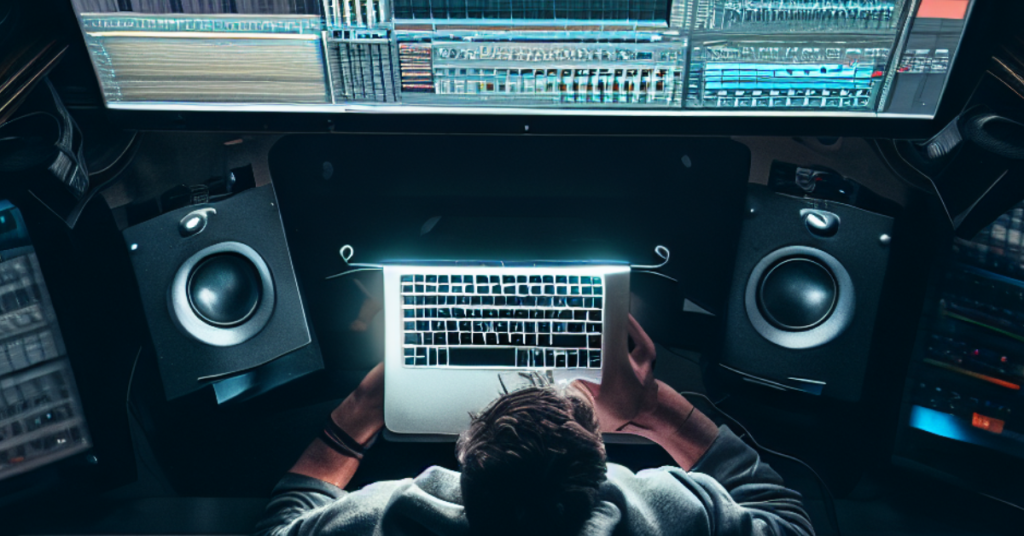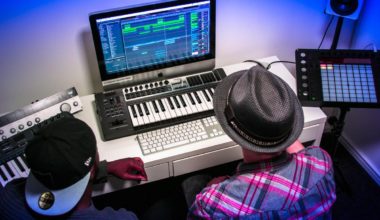
Hello, sound architects of the digital age! If you’re here, it’s likely that you’ve been making serious strides in your music production journey. Your talent is starting to overflow, your creativity is bursting at the seams, and your current computer setup might be gasping for breath trying to keep up. You’re probably asking yourself, “What’s the magic number when it comes to RAM for music production?” Don’t worry, we’ve all been there.
Picture yourself as a conductor. You have an orchestra at your command, ready to create breathtaking symphonies, innovative sounds, and memorable melodies. But what happens when your orchestra starts to grow beyond your control? You’ll need a larger stage, right? Well, consider RAM as that bigger stage in the world of music production. It allows your digital orchestra – the multitude of tracks, plugins, and samples – to perform without tripping over each other.
Just as a symphony orchestra wouldn’t fit in your living room, your ambitious projects might need more RAM than your current system can provide. But we’re not talking about physical space; we’re talking about the digital ‘real estate’ that allows your creativity to roam freely. Let’s dive into how much of that digital space you’ll need to let your music production dreams fly.
The Heartbeat of Your Production: What is RAM?
Imagine a bustling city where all the magic happens – in our case, the music. Now, the city, full of sound and beats, is your computer’s processor (CPU). RAM (Random Access Memory) is like the city’s infrastructure, the highways and roads allowing data to move quickly and efficiently to and from the bustling city center.
RAM is your computer’s short-term memory, if you will. It temporarily stores data that your processor may need in the immediate future. Picture it as a high-speed storage locker where all the essential bits and pieces of your music production workflow are held. Every beat you craft, every synth line you experiment with, every plugin you utilize, they all hang out in this locker, ready to spring into action the moment you need them.
Think of RAM as your right-hand man in the music production process. The more you have, the larger your right-hand man’s capacity to handle the workload becomes. A bigger locker allows more simultaneous sound elements to be stored and retrieved quickly. This means smoother workflow, quicker loading times, and overall, a better music production experience.
However, a word of caution – RAM isn’t everything. It’s like the bass player in your band; important, but it can’t make music on its own. You need other components like a good processor (CPU), a fast hard drive (SSD), and efficient cooling to ensure your music-making machine can perform at its best. But the question remains, how much RAM do you need? Let’s delve into this intriguing matter.
The Bare Necessities: RAM Minimum for Music Production
When it comes to music production, we need our fair share of resources. Whether it’s sample packs that fill up your hard drive or the processor power needed for that super-advanced reverb plugin, one thing is clear: music production can be demanding.
In this realm, the digital symphony of sounds is orchestrated by software. Digital Audio Workstations (DAWs), plugins, virtual instruments – these are the players in your digital orchestra, and they love hanging out in RAM, the magical locker we talked about earlier. These guys are a bit like divas – they demand space, and they demand it now!
Now, let’s talk about that magic number – 8GB. This amount of RAM is the bare minimum you’ll need for music production. It’s like a small but cozy apartment for your music software. Just enough room to invite a few friends over and have a jam session.
However, if your computer setup is akin to a multi-tasking marvel, running memory-heavy applications alongside your DAW (think of video editing, 3D modeling, or perhaps a little gaming on the side), then 8GB might feel a little cramped. It’s like trying to squeeze a drum kit, a grand piano, and a five-piece band into that small apartment. It could work for a while, but it’s not exactly comfortable.
Remember, having the bare minimum is okay when you’re just starting. We all need to start somewhere, and sometimes, smaller is better. A compact space often leads to innovative solutions and unexpected bursts of creativity. But as your music production journey progresses and your needs grow, so should your RAM.
Stepping Up Your Game: Recommended RAM for Music Production
Okay, so you’ve been composing some killer tracks, and you’re ready to step up your game. You want to expand your digital orchestra, introduce new plugins, and start pushing the boundaries of your creativity. That’s fantastic, but it’s at this stage that your computer might start to groan under the load.
Think of it this way: you started with a cozy apartment, but now you have a five-piece band, a host of instruments, and a desire to host more jam sessions. It’s time for an upgrade. From our cozy apartment, we’re now stepping up to a full-fledged suburban house – that’s 16GB of RAM.
This new space is perfect for the average music producer. It’s a comfortable middle ground, providing enough room for your DAW to breathe while accommodating multiple plugins, tracks, and virtual instruments without breaking a sweat. It’s the sweet spot where your machine’s capabilities align nicely with your musical ambitions.
Picture your DAW and plugins as a family. In an 8GB setting, they’re constantly bickering for space, competing for attention. But with 16GB, each family member has their own room, their own space to thrive. Your DAW can access more sounds faster, your plugins can operate more efficiently, and your tracks can load without causing a slowdown.
And while the benefits of a RAM upgrade are evident, don’t let the allure of a bigger ‘house’ make you complacent. Expanding your capabilities also means you need to manage your resources wisely. Keep an eye on your DAW and the plugins you use. Make sure they’re updated regularly and optimized for your system.
Stepping up to 16GB of RAM isn’t just about getting more space – it’s about growing as a music producer, refining your workflow, and unlocking your full creative potential.
Unleash the Beast: Heavy-Duty RAM for Music Production
Alright, so you’ve been producing music for a while now. Your beats are tighter than ever, your melodies are turning heads, and you’re starting to dabble in larger, more complex productions. You’re pushing your software and hardware to their limits, layering track upon track, and your plugin library is growing faster than a teenager during a growth spurt.
In this case, it’s time to consider moving into the downtown penthouse of the digital world. Welcome to the 32GB+ club, where the rooms are large, the view is fantastic, and your music has the space to resonate and echo in all its glory.
Having 32GB or more RAM is like having a super-sized playground for your DAW and plugins. There’s plenty of room to romp around without bumping into each other. Larger projects with more tracks, heavier plugins, and more intensive processing can be handled with ease. It’s like having an entire music festival taking place smoothly within the confines of your computer.
This amount of RAM is particularly beneficial if you’re working with sample-heavy compositions or high-quality orchestral libraries. These sonic wonders can eat up memory like a starved artist devouring a post-gig feast. But with 32GB+ RAM, you’ll be sitting comfortably, watching the feast unfold, and not worrying about running out of food.
But let’s be clear here. Just like owning a penthouse isn’t for everyone, this level of RAM isn’t necessary for every music producer out there. It’s for those who are serious about their craft, those who need their computer to perform like a well-oiled symphony, and those who are consistently pushing their creativity and technical skills to the limit.
In the end, upgrading to a heavy-duty RAM setup is not just about unleashing the beast within your computer. It’s about unleashing the beast within you, giving your musical instincts the space they need to roar.
Beyond the Numbers: Other Factors to Consider
When thinking about “How much RAM for music production,” it’s crucial to remember that RAM isn’t the only player in our music production ensemble. It’s a key player, absolutely, but it doesn’t perform the concert solo. It’s part of a team, a well-coordinated band that works together to bring your musical creations to life.
Imagine you’ve got a top-notch drummer (RAM), but your guitarist (CPU) and bassist (hard drive) can’t keep up. Your band’s overall performance will still be lackluster. The same applies to your computer setup. Upgrading your RAM will indeed boost your system’s performance, but there are other components that you need to pay attention to as well.
First off, there’s the CPU. Your processor is essentially the band leader of your computer’s band. It oversees all the operations and ensures everything runs smoothly. The more cores and higher the clock speed, the better your CPU can handle demanding tasks like music production.
Next, consider your hard drive. Traditional hard drives (HDDs) are like cassette tapes – they’ve served us well, but they’re a bit out of date. Today’s SSDs (Solid State Drives), on the other hand, are like streaming platforms – fast, efficient, and more reliable. A good SSD can significantly reduce loading times for your DAW and plugins, making your music production experience even smoother.
Additionally, think about your computer’s cooling system. When you’re producing music, your computer works hard, and when it works hard, it heats up. An effective cooling system prevents your computer from overheating and causing performance drops or even worse, hardware damage.
Last but not least, don’t forget the software. Ensure that your DAW and plugins are regularly updated and optimized for your system. Software developers continuously improve their products, making them more efficient and compatible with various hardware configurations.
In the grand scheme of things, understanding your needs and balancing them against your budget is key. Remember, an optimal music production setup is not just about how much RAM you have; it’s about the harmony between all the components in your system.
Final Thoughts and Product Recommendations
The quest for the answer to “How much RAM for music production” is akin to finding the right instrument for your music. There’s no one-size-fits-all answer because the choice greatly depends on your unique needs, ambitions, and the complexity of your projects.
In the world of music production, RAM is the unsung hero that keeps your creative process running smoothly. It’s the backstage crew that ensures your performance goes off without a hitch. But remember, it works best in harmony with a well-rounded computer setup. So, while it’s essential to invest in enough RAM, don’t forget about the other members of the band, namely the CPU, hard drive, cooling system, and software.
Now that you’re well-versed in the role of RAM in music production, here are some product recommendations that meet various levels of needs:
For Desktop PCs:
- Dell XPS Desktop Special Edition (8940): With options for up to 64GB of RAM and a 10th gen Intel Core i9 processor, this machine is ready to handle your most complex compositions.
- Corsair Vengeance LPX 32GB (2 x16GB) DDR4 3200MHz C16: This high-performance memory kit will provide the RAM boost your current PC might need, helping you smoothly run those hefty plugins and DAWs.
For Desktop Macs:
- 27-inch iMac with Retina 5K display: You can configure this beauty with up to 128GB of RAM. With an excellent display and great performance, it’s a fantastic tool for music production.
- Mac Pro: The ultimate choice for heavy-duty production. With the capability to support a whopping 1.5TB of RAM, this machine is a beast.
For Laptops:
- HP Envy x360: A budget-friendly option, the HP Envy x360 comes with up to 16GB RAM and has an excellent build quality.
- Dell XPS 15: For those looking for more power, the Dell XPS 15 offers up to 64GB of RAM. It’s a portable powerhouse perfect for music production.
- Apple MacBook Pro 16-inch: For Mac lovers, this laptop offers up to 64GB of RAM and features Apple’s custom silicon chip, promising great performance.
Remember, the best computer for music production is the one that best suits your unique needs and fits within your budget. And when it comes to RAM, the golden rule is: the more, the merrier, but always in balance with your other components.





